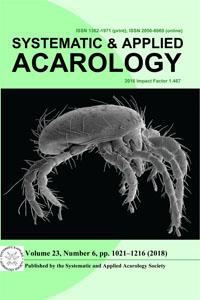A new genus, Tumescoptella n. g., with two new sympatric species Tumescoptella aculeata n. sp. and T. rotundiscuta n. sp., was found on the indigenous South African palm Hyphaene coriacea, Lala palm. Both species are described and illustrated with the aid of conventional light microscopy, confocal laser scanning microscopy and low temperature scanning electron microscopy. Additionally, a new record of Tumescoptes dicrus Meyer collected from Phoenix reclinata (Arecaceae), near Kirstenbosch Gardens (Cape Town, South Africa), is reported. Morphologically the Tumescoptella n. g. is most similar to Tumescoptes Keifer, but possesses a more reduced chaetome and more derived pseudotagmosis. Pseudotagmosis is one type of body consolidation in vagrant eriophyoids, realized through the formation of dorsal opisthosomal plates, pseudotagmata. Along with previously described pseudotagmata (prodorsum, cervix, postprodorsum, superpostprodorsum, pretelosoma, and telosoma), a new term, anteroscutum, is proposed for the complex pseudotagma formed as a fusion of the three anterior pseudotagmata (prodorsum cervix postprodorsum) in several phyllocoptine mites from palms. An anteroscutum is present in monotypic Scolocenus Keifer from coconut and in the new genus Tumescoptella n. g. Protogyne females of Tumescoptella n. g. have uncommonly large lateral opisthosomal spines. Along with tiny spinules, triangular cuticular plates, band-shaped processes, and areas of thickened cuticle, the lateral spines belong to a common group of serial derivatives of dorsal opisthosomal annuli. We give a brief review on variation of spine-like structures across taxa of Eriophyoidea and their morpho-functional evaluation. Contrary to protogyne females, deutogyne females of T. aculeata n. sp. lack lateral spines, and they possess a smoother topography of the anteroscutum. Morphological similarity of these deutogynes with mites of the less transformed genus Tumescoptes is in accordance with a previous hypothesis on the possible correspondence of deutogyne morphology to that of an ancestral taxon. Two hypotheses on the origin of the presumably monophyletic group of Tumescoptes-like phyllocoptines (TP) from palms, comprising genera Scolocenus, Tumescoptella n. g., Tumescoptes, and Pseudotagmus, are proposed based on morphological similarity with two groups of eriophyoid genera: (a) pseudotagmic genera associated with aboriginal Asian dicotyledonous tropical trees, and (b) South American phyllocoptines from arecoid palms.
How to translate text using browser tools
7 June 2018
New pseudotagmic genus of acaricaline mites (Eriophyidae, Acaricalini) from a South African palm Hyphaene coriacea and remarks on lateral opisthosomal spines and morphology of deutogynes in Eriophyoidea
Philipp E. Chetverikov,
Charnie Craemer,
Stefan Neser
ACCESS THE FULL ARTICLE

Systematic and Applied Acarology
Vol. 23 • No. 6
June 2018
Vol. 23 • No. 6
June 2018
Arecaceae
arthropod structure
CLSM
LT-SEM
palm mites
pseudotagma
wax




